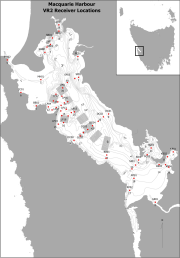Saturation of oxygen {O2} in the water body [dissolved phase]
Type of resources
Topics
Keywords
Contact for the resource
Provided by
Years
-
This study considered a range of water-column and sediment (benthos) based variables commonly used to monitor estuaries,utilising estuaries on the North-West Coast of Tasmania (Duck, Montagu, Detention, and Black River). These included: salinity, dissolved oxygen, turbidity, nutrient and chlorophyll a levels for the water-column; and sediment redox, organic carbon content, chlorophyll a and macroinvertebrate community structure amongst the benthos. In addition to comparing reference with impacted estuaries, comparisons were also made across seasons, commensurate with seasonal changes in freshwater river input, and between regions within estuaries (upper and lower reaches) - previously identified in Hirst et al. (2005). This design enabled us to examine whether the detection of impacts (i.e. differences between reference and impacted systems) was contingent on the time and location of sampling or independent of these factors. This data includes sampling from Duck River, Montagu River, Detention River, and Black River.
-

Fixed position oxygen and water temperature logger data from the Macquarie Harbour World Heritage Area (WHA). Two Hobo oxygen data loggers are positioned at approximately 15 m depth at different sites within the WHA, with the intent of monitoring representative mid-bottom water oxygen values in the WHA as these were identified in previous studies to be naturally low due to limited seawater exchange at the harbour entrance, and thus likely to be most susceptible to anthropogenic factors that may increase oxygen demand and alter WHA conservation values. These values include core habitat of the Maugean Skate, a listed threatened species. This work is funded by WHA advisory board via the Nature Conservation Branch of DPIPWE and is part of a larger study being conducted by IMAS undertaking a biological baseline study of the biodiversity of the Macquarie Harbour WHA. This data spans 08/11/14 to present (most recent update 02/02/17).
-
We implemented a monitoring program developed by Crawford and White (2006), which was designed to assess the current condition of six key estuaries in NW Tasmania: Port Sorell, the Leven, Inglis, Black, Montagu and Arthur River estuaries. This study considered a range of water quality and ecological indictors commonly used to monitor estuaries. These included: salinity, temperature, dissolved oxygen, turbidity, pH, nutrients (nitrate + nitrite, dissolved reactive phosphorus and ammonia), silica molybdate reactive and chlorophyll a for the water column; chlorophyll a and macroinvertebrate community structure amongst the sediments.
-
Water temperature, averaged across the water column, in Storm Bay followed a distinct seasonal cycle each year, reaching a low of 9 °C and a high of ~ 19 °C. Warmest temperatures were in February, followed by a gradual cooling throughout autumn to a winter minimum in August, then increasing again during spring. Across the sites, the median temperature varied little, with site 3, the most marine of the sites, showing the least spread in values. Median salinity varied little across Storm Bay, being slightly higher at sites 3 and 6, highlighting the marine nature of site 3 and the patterns of seawater circulation in Storm Bay. The lowest salinities were recorded at site 1, where less saline surface waters flow into the bay from the Derwent Estuary. Seasonally, salinity was highest in autumn, with slightly fresher water present in Storm Bay in spring. Some lower salinity values were recorded in July and August, suggesting the presence of less saline subantarctic water flowing into the bay, or freshwater flow from the Derwent. Glider transects show slight lower salinity in summer, then mild stratification in autumn to spring, especially in the shallow regions near the mouth of the Derwent.
 TemperateReefBase Geonetwork Catalogue
TemperateReefBase Geonetwork Catalogue